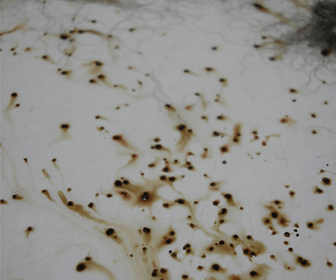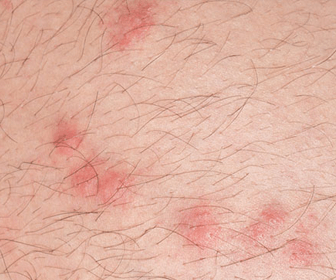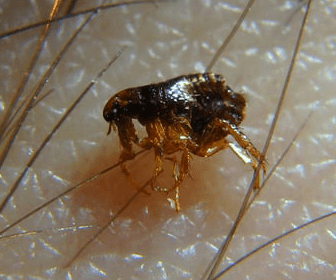I really hate fleas, and the thought of them hiding in my bed makes me very uneasy. Unfortunately, although your mattress and linen is not their preferred place to live, the warmth and availability of food (you), especially when there are no animals nearby, make it a real possibility. Let’s see what we can do about it.
- If you are short on time, click here for a quick summary of this guide.
- Three signs that fleas could be lurking in your bed (with pictures).
- Can they live in your bed, and can you proactively keep them out?
- How to get rid of fleas in the bed in three easy steps (DIY friendly).
- A couple popular FAQ about dealing with these pests in your bedding.
Three signs that fleas could be lurking in your bed (with pictures):
You have unexplained marks: Although it is a bit disturbing, finding random bites on your body when you wake up in the morning doesn’t confirm that you have fleas in your bedroom. There are many different types of insects that like to nibble on humans, such as mosquitoes or bed bugs. However, if the marks are in small clusters (3-4x in a single spot), this is a potential sign that these pests are lurking nearby.
You find an insect that jumps: Since not everyone knows what these pests look like, if you see a tiny critter that quickly jumps out of sight, it is likely a flea. The adults have specially adapted legs that allow them to leap large distances (relative to their size), and when exposed to light, they usually try and hide immediately. If you catch the insect but are unsure what it is, leave a comment and I’ll help you identify it.



PRO TIP: Finding out what pest is biting you is crucial, as it allows you to be a lot more effective when it comes to extermination. However, regardless of the insect, if you have been bitten I recommend using a little antibacterial soap on the area to sooth the ichiness (vinegar works well as well). Since everyone reacts differently, please consult a doctor if symptoms continue to worsen.
Can they live in my bed, and can I proactively keep them out?
Yes, fleas can live in your bed, but they usually won’t actively seek you out, especially since animal blood is their preferred diet. In fact, they are often only in the bed in the first place because they were dislodged from a pet that curled up next to you (especially cats). If you let them linger, they are likely to lay eggs, which are very difficult to see and will hatch when conditions are right. Although it can be tricky, this something to look out for when purchasing a second-hand mattress. What can you do to keep them out your bed?
Treat your house and yard:I have had excellent results with diatomaceous earth, borax powder, baking soda and even salt for indoor use, and beneficial nematodes are a great choice for outside. Although chemicals have their place, don’t presume that chemicals are always the “better” choice in every circumstance.
Minimize contact with fleas: Despite our lack of fur, it is still very possible for fleas to hitch a ride home with you if you have visited an infested area (especially dog parks, etc.). Don’t let this put you off from doing things you enjoy, but if you do come into contact, wash your clothes and take a hot shower. Additionally, if you see your pet scratching, don’t let him on your bed, and take a few moments to check if they are the reason for the itchiness.
How to get rid of fleas in the bed in three easy steps:
If you have found these pests snuggled in your mattress, please don’t fret. There are easy, effective ways to deal with these unwelcome guest and keep them away for good. Your only challenge will be to make sure that you repeat these steps every two weeks, for about six weeks, to break the life cycle of the fleas. Tackle these three steps, and you will get rid of them.
Step 2 – Mattress in the sun: Although fleas enjoy warm, humid temperatures, they are sensitive to direct sunlight and extreme heat. By placing your mattress out in the sun on a hot day for as many hours as possible, you will get rid of any unwelcome critters and their eggs, as they will not survive such an inhospitable environment. Be sure to turn the mattress over to ensure that the bright sunlight reaches every inch of your mattress, and don’t forget to bring it inside if the weather turns bad.
Step 3 – Kill remaining fleas: Focus your attention on your bedroom, taking special care to treat the entire room. If you have carpet in your bedroom, vacuum thoroughly and treat it with salt and baking soda, paying particular attention to dark corners and underneath the bed. Hardwood floors can be washed and misted over with a homemade or commercial flea repelling spray. Spray inside the bottom edges of cupboards and along the skirting boards around the room perimeter.
PRO TIP: In addition to the steps above, if you want to go the extra mile, there are two more things you can do. Firstly, put a little diatomaceous earth, baking soda or borax powder under your sheet (just sprinkle it lightly), which will kill any remaining fleas on contact. Secondly, make yourself a DIY peppermint spray and put a little on each corner of your bed sheet, which will repel them (they hate the smell). This should give you some immediate relief and hopefully allow you to get a good nights sleep.
If you are short on time, here’s quick summary of this guide:
There are a few, obvious signs that you have these pests lurking about in your bed. If you have been bitten, you will have small, itchy red marks in clusters or straight lines on your body (often focused on ankles, legs and in folds of skin). On careful examination of your bed and bedding, you will usually find evidence of flea dirt, which is mostly made up of dried blood. You may also catch the fleeting glimpse of a tiny, dark brown insect jumping quickly out of sight when it’s disturbed from its cozy hiding place.
Your bed is not a flea’s ideal habitat, and will usually find itself in your private domain simply because it was dislodged from a furry host who is allowed onto your bed. The first line of defense is to deflea your pooch or kitty; after that, you will have to treat your house and yard. This can be achieved by vacuuming carpets, spraying hardwood and tiled floors and clearing damp rotting debris from the garden. You should also wash any clothing that has come into contact with them in hot water.
Three simple steps will ensure that you create a comfortable, flea free bed to crash into after a hard day of work. Firstly wash all your bed linen on the hottest wash cycle in your washing machine. Secondly, place your mattress outside in hot, direct sunlight, and expose both sides to the sun. Lastly, treat the room for these insects, and for bonus protection, apply some natural bug killing powder under your sheet and put a little peppermint oil on the corners of the bed.
A couple popular FAQ about dealing with these pests in your bedding:
Will fleas always visible in my bedding? Unfortunately not, they avoid the light and will always try to hide in a dark spot, making these tiny insects hard to find. It’s easier to search in folds and crevices of your bedding and mattress for their “dirt”. It looks like black pepper grinds and turns reddish-brown when moistened.
I don’t have DE, can I use something else to kill them? Yes, several completely natural products will make your bed a most undesirable abode for fleas. Use a thin layer of baking soda or a combination of salt and baking soda to kill eggs and larvae. Epsom salts will also convince them to make a hasty retreat from your bed.
Is a mattress protector necessary for immature fleas? If you have one available, feel free to use it, but I don’t think that it is necessary to go out and buy one. If you have put some natural insect powder under your sheet, both adult and immature fleas will die eventually, and the peppermint oil will keep them away from your bed.
How can I test if any fleas are hiding in my bedroom? Despite what many other guides saying, I have personally found that a DIY trap is much better at the discovery process (and it can even help kill them). Check out this guide to learn how to make it at home, as this is a much cheaper option that buying them prebuilt.
I don’t even have pets, how did my bed get fleas? Although it is more common for pets to be the cause, they actively seek out warm-blooded hosts in their environment. While it is true that they prefer animals, if they cannot find one, they are likely to come for you. If you don’t have pets, keep a lookout for rats and feral cats.
I got bitten while asleep, how can I tell if it was a flea? Their bites differ from the bites of other pests, and they are usually itchy, leave little red marks (clustered or in a straight line), and don’t result in swelling (unless you are hypersensitive). If you are unsure, please reach out to me, and I will help you with some identification.
That’s about it; thank you for taking the time to read this guide. If you have any questions about it or are still battling with an infestation in the bedroom after applying these tips, please leave a comment below and I will help you (even if you are reading this 10 years after I post it lol).
Hello! My name is Natasha, and I have been helping people with their insect problems since 2012. I have published a book, worked with many pest control companies, and helped thousands with various infestations on a one-to-one basis. My goal for this blog is to create evidence-based guides that are easy to understand, provide sufficient depth and can be trusted to be very accurate. Please remember that my guides are for informational purposes only, and that you agree to the terms of use when reading content on this website. If you leave a comment, I typically respond within 48 hours.



Speak Your Mind